It’s February. Guess what that means, yup an update by the Department of Water Resources (DWR) of the state’s snowpack.
Yesterday’s manual snow survey by DWR recorded 48.5 inches of snow depth and a snow water equivalent of 19 inches, which is 109 percent of average for this location for this date. The snow water equivalent measures the amount of water contained in the snowpack and is a key component of DWR’s water supply forecast. Statewide, the snowpack is 92 percent of average for this date.
Normally, numbers like these would be encouraging, however a dry January reminds all Californians that a third dry year may be on the way.
“We are definitely still in a drought. A completely dry January shows how quickly surpluses can disappear,” said DWR Director Karla Nemeth. “The variability of California weather proves that nothing is guaranteed and further emphasizes the need to conserve and continue preparing for a possible third dry year.”
Another encouraging sign is DWR reported that Sierra snowmelt during January has been minimal. In order for the state’s “frozen reservoir” to remain at above average levels a return of winter storms are needed in February and March.
“These dry January conditions demonstrate the importance of continuing to improve our forecasting abilities and why these snow surveys are essential,” said Sean de Guzman, Manager of DWR’s Snow Surveys and Water Supply Forecasting Unit. “While we always hope for a generous snowpack, DWR’s ongoing investments in forecasting techniques will help the state better prepare for both drought and flood conditions.”
In light of last year’s poor runoff, DWR has increased its efforts to improve climate and runoff forecasting by strengthening its collaboration with partner agencies and academia and by investing in proven technologies to improve data collection and hydrologic modeling. One example is DWR’s investment in remote snowpack measurements through the Aerial Remote Sensing of Snow program by partnering with Airborne Snow Observatories, Inc. (ASO). Data from ASO has proven to be the most accurate assessment of snowpack conditions that, when coupled with newer, sophisticated runoff models, will improve runoff forecast accuracy.
DWR conducts four media-oriented snow surveys at Phillips Station each winter near the first of each month, January through April and, if necessary, one additional in May.
 California Water News Daily Your Source For Water News in California
California Water News Daily Your Source For Water News in California


